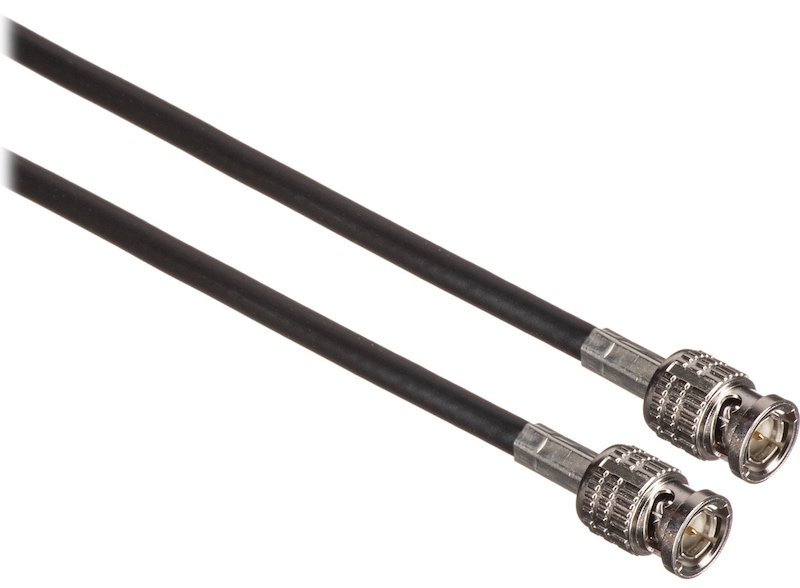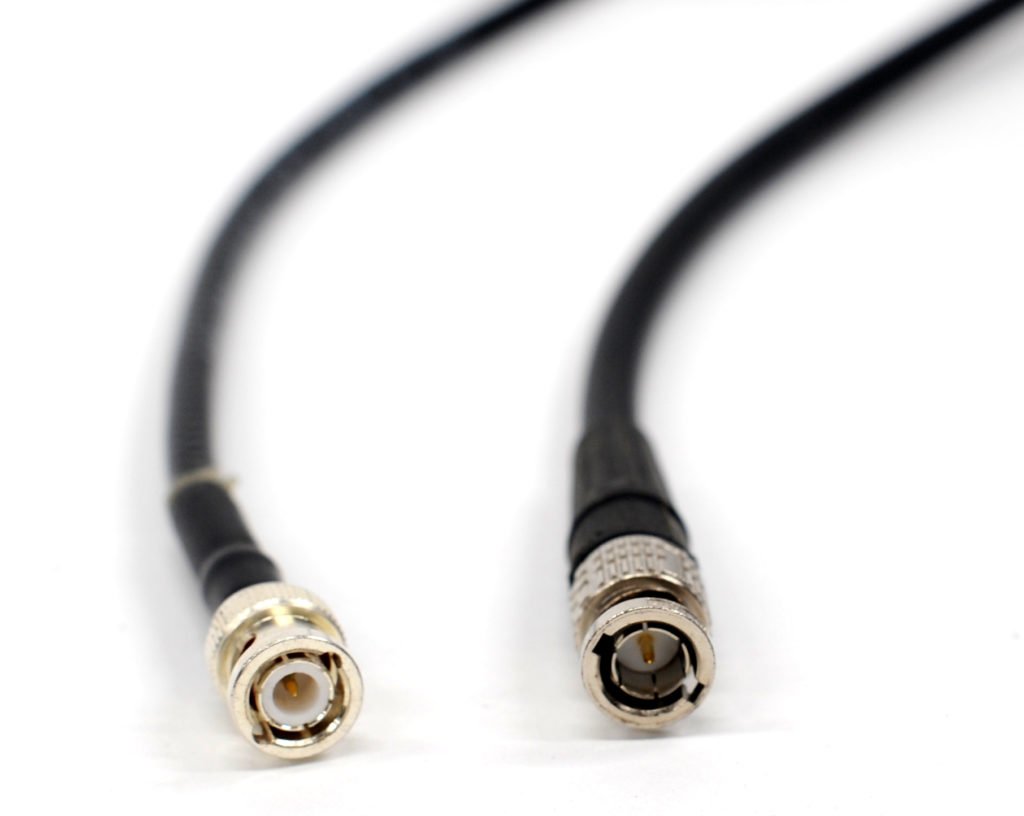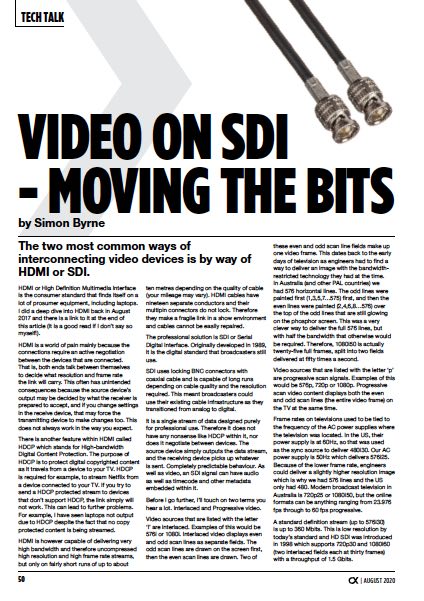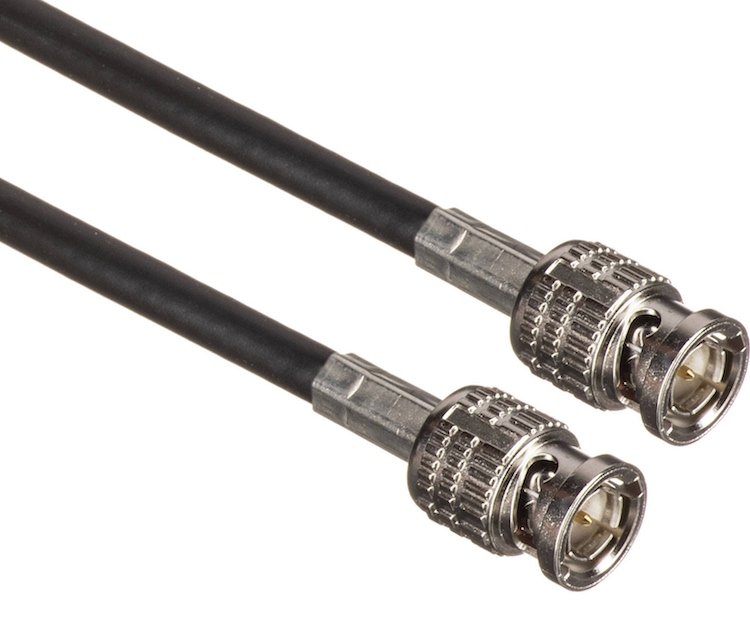News
17 Aug 2020
Video on SDI – Moving the Bits

Subscribe to CX E-News
The two most common ways of interconnecting video devices is by way of HDMI or SDI.
HDMI or High Definition Multimedia Interface is the consumer standard that finds itself on a lot of prosumer equipment, including laptops. I did a deep dive into HDMI back in August 2017 and there is a link to it at the end of this article (it is a good read if I don’t say so myself!).
HDMI is a world of pain mainly because the connections require an active negotiation between the devices that are connected. That is, both ends talk between themselves to decide what resolution and frame rate
the link will carry.
This often has unintended consequences because the source device’s output may be decided by what the receiver is prepared to accept, and if you change settings in the receive device, that may force the transmitting device to make changes too.
This does not always work in the way you expect.
There is another feature within HDMI called HDCP which stands for High-bandwidth Digital Content Protection. The purpose of HDCP is to protect digital copyrighted content as it travels from a device to your TV. HDCP is required for example, to stream Netflix from a device connected to your TV.
If you try to send a HDCP protected stream to devices that don’t support HDCP, the link simply will not work. This can lead to further problems. For example, I have seen laptops not output due to HDCP despite the fact that no copy protected content is being streamed.
HDMI is however capable of delivering very high bandwidth and therefore uncompressed high resolution and high frame rate streams, but only on fairly short runs of up to about ten metres depending on the quality of cable (your mileage may vary).
HDMI cables have nineteen separate conductors and their multipin connectors do not lock. Therefore they make a fragile link in a show environment and cables cannot be easily repaired.
The professional solution is SDI or Serial Digital Interface. Originally developed in 1989, it is the digital standard that broadcasters still use. SDI uses locking BNC connectors with coaxial cable and is capable of long runs depending on cable quality and the resolution required.
This meant broadcasters could use their existing cable infrastructure as they transitioned from analog to digital.
It is a single stream of data designed purely for professional use. Therefore it does not have any nonsense like HDCP within it, nor does it negotiate between devices. The source device simply outputs the data stream, and the receiving device picks up whatever is sent.
Completely predictable behaviour. As well as video, an SDI signal can have audio as well as timecode and other metadata embedded within it. Before I go further, I’ll touch on two terms you hear a lot. Interlaced and Progressive video.
Video sources that are listed with the letter ‘I’ are interlaced. Examples of this would be 576i or 1080i. Interlaced video displays even and odd scan lines as separate fields. The odd scan lines are drawn on the screen first, then the even scan lines are drawn.
Two of these even and odd scan line fields make up one video frame. This dates back to the early days of television as engineers had to find a way to deliver an image with the bandwidth-restricted technology they had at the time.
In Australia (and other PAL countries) we had 576 horizontal lines. The odd lines were painted first (1,3,5,7…575) first, and then the even lines were painted (2,4,6,8…576) over the top of the odd lines that are still glowing on the phosphor screen.
This was a very clever way to deliver the full 576 lines, but with half the bandwidth that otherwise would be required. Therefore, 1080i50 is actually twenty-five full frames, split into two fields delivered at fifty times a second.
Video sources that are listed with the letter ‘p’ are progressive scan signals. Examples of this would be 576p, 720p or 1080p. Progressive scan video content displays both the even and odd scan lines (the entire video frame) on the TV at the same time.
Frame rates on televisions used to be tied to the frequency of the AC power supplies where the television was located. In the US, their power supply is at 60Hz, so that was used as the sync source to deliver 480i30. Our AC power supply is 50Hz which delivers 576i25.
Because of the lower frame rate, engineers could deliver a slightly higher resolution image which is why we had 576 lines and the US only had 480. Modern broadcast television in Australia is 720p25 or 1080i50, but the online formats can be anything ranging from 23.976 fps through to 60 fps progressive.
A standard definition stream (up to 576i30) is up to 360 Mbits. This is low resolution by today’s standard and HD SDI was introduced in 1998 which supports 720p30 and 1080i60 (two interlaced fields each at thirty frames) with a throughput of 1.5 Gbits.
With the development of plasma and LCD screens, progressive scan formats became popular. That means twice the bandwidth (about 3 Gbits) so Dual Link HD-SDI was developed as an interim measure which allowed for 1080p60 across two 1.5 Gbit HD SDI links.
That is a single stream shared across two cables.
As technology developed, Dual Link HD-SDI was replaced with 3G SDI which is 3 Gbits on a single cable. Despite this, Dual Link technology is still implemented at higher resolutions in for example, Blackmagic Design’s Decklink video input cards.
Now in 3G it gets interesting. There are two variants of 3G SDI, level B and A. Level B is an extension of Dual Link HD-SDI. That means that the engineers took the Dual Link streams, combined and stuffed them down one 3G SDI cable.
This was a cost-effective way to extend the technology and level B is found in lower end, older gear. Level B is occasionally used to deliver two HD SDI signals into a single cable for stereoscopic video.
Level A is a true single stream of data. Newer and higher end gear benefits from level A. Level A and B streams are not compatible with each other, however most modern equipment is capable of accepting either.
Building on 3G, there is 6G which is obviously a 6 Gbit stream. A 6G stream is capable of 1080p120 or 2160p30 (4K at 30 frames per second). There hasn’t been much take-up of 6G, mainly because 12G is available which can deliver 2160p60.
Those are all the current standards, but the boffins are developing 24G which is capable of 4320p30, a massive 7680 x 4320 pixel image at 30fps.
SDI Standards and their Capacities
| Name | Introduced | Bitrates | Examples video Formats |
| SD-SDI | 1989 | 177 Mbits, 360 Mbits | 480i, 576i |
| HD-SDI | 1998 | 1.5 Gbits | 720p, 1080i |
| Dual Link HD-SDI | 2002 | 1.5 Gbits+1.5 Gbits = 3 Gbits | 1080p50 |
| 3G-SDI | 2006 | 3 Gbits | 1080p50 |
| 6G-SDI | 2015 | 6 Gbits | 080p120, 2160p30 |
| 12G-SDI | 2015 | 12 Gbits | 2160p60 |
| 24G-SDI | 24 Gbits | 2160p120, 4320p30 |
The Cable and Connectors
SDI runs on 75 ohm coaxial cable and the great thing about that is you can make your own cable assemblies. However, there is a huge difference in cable quality and this defines how reliable and to what length an SDI run can be.
RG59 or RG6 (better) are the standard, and runs of one hundred metres can be achieved at 1080i50 with most cables. But at 3G data rates and upwards, you really want a cable that is specifically designed to work at those rates.
You should be aware that RG58 is another common cable that looks exactly the same as RG59 but importantly its impedance is 50 ohms as it is designed for use with antennas.
An SDI signal on a RG58 cable will perform poorly. You can easily tell the difference between a 50 ohm RG58 BNC and a 75 ohm RG59. RG58 have a plastic dielectric between the pin and the shield of the plug whereas RG59 usually don’t.

The quality of the BNC connectors is extremely important. The signal travels along the dielectric between the core and the shield, so the interface between the cable and connector is where you can lose an enormous amount of signal integrity.
For this reason, I only use Canare BNCs because they just work. I don’t think I can recall a time when one has failed. It should be noted that to fit a BNC with a good crimp connection, the right crimp tool with the correct crimp die is incredibly important. The cheaper tools are not made to the tolerances required for a good join.
You can run SDI over fibre with converters which opens up runs measured in kilometres. The convertors do nothing to the signal other than convert it to light and back again so it is a very reliable method. There are typically two strands in a fibre cable, which means you can send two signals in a run.
The other benefit is that fibre is future-proof because of its enormous bandwidth. The downsides to fibre is that it is delicate and the tools required to do terminations are very expensive. It is better to buy pre-built fibre cables for these reasons.
Converting SDI to HDMI
The problem with SDI is that most prosumer devices and monitors do not have an SDI connection. This is because SDI is usually available only in professional video equipment because various licensing agreements restrict the use of unencrypted digital interfaces. So a converter to HDMI is required.
Fortunately these are now quite cheap and can be USB powered. With my monitors that only have HDMI, they all have Blackmagic Designs SDI to HDMI converters, velcroed to the back of them and powered by the USB ports on the monitor.
With these, I have well priced monitors with professional SDI inputs.
What about video over Cat5e or Cat6 cable and IP network infrastructure?
There is a surprisingly low take-up on this, probably because compression is required, and most broadcasters are already based around SDI.
The leading protocol is Newtek’s NDI which they licence to other manufacturers. A standard 1080p25 is just on 100 Mbits. That means it is compressed by a factor of fifteen when compared to an uncompressed SDI stream at 1.5 Gbits.
The compression is quite good, but cannot be as good as uncompressed, but also with any compression you add latency because the system must load a frame before it can be compressed.
I wrote about NDI back in August 2018, the link to that article is below.
SDI is a rock solid and mature solution. I suspect it is going to stay with us for a while.
Check out these other related articles:
HDMI and HDCP – A World of Pain
https://www.cxnetwork.com.au/hdmi-and-hdcp-a-world-of-pain
NDI – Professional Video Over IP
https://www.cxnetwork.com.au/professional-video-over-ip
CX Magazine – August 2020
LIGHTING | AUDIO | VIDEO | STAGING | INTEGRATION

Entertainment technology news and issues for Australia and New Zealand
– in print and free online www.cxnetwork.com.au
© VCS Creative Publishing
Subscribe
Published monthly since 1991, our famous AV industry magazine is free for download or pay for print. Subscribers also receive CX News, our free weekly email with the latest industry news and jobs.







